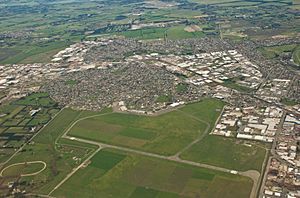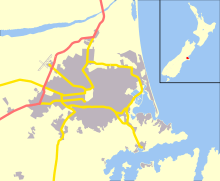Wigram Aerodrome facts for kids
Quick facts for kids
Wigram Aerodrome
|
|||||||||||||||||||
|---|---|---|---|---|---|---|---|---|---|---|---|---|---|---|---|---|---|---|---|
 |
|||||||||||||||||||
| Summary | |||||||||||||||||||
| Airport type | Public | ||||||||||||||||||
| Operator | Wigram Aerodrome Ltd. | ||||||||||||||||||
| Serves | Christchurch | ||||||||||||||||||
| Location | Wigram | ||||||||||||||||||
| Elevation AMSL | 74 ft / 23 m | ||||||||||||||||||
| Coordinates | 43°33′04″S 172°33′10″E / 43.55111°S 172.55278°E | ||||||||||||||||||
| Map | |||||||||||||||||||
| Runway | |||||||||||||||||||
|
|||||||||||||||||||
| RNZAF Base Wigram | |
|---|---|
| Active | 1917–1995 |
| Country | |
| Branch | |
| Type | Training Base |
| Motto(s) | Latin: In Deo Et In Alis Salus ("Safety is in God and our wings") |
| Colors | Red and Black |
Wigram Aerodrome was an important airfield located in Christchurch, New Zealand. It started as Sockburn Airport and was later renamed Wigram. This airfield played a big role in New Zealand's aviation history.
It was first given by Sir Henry Wigram to the Canterbury (NZ) Aviation Company in 1916. Later, in 1923, it became a base for the Royal New Zealand Air Force (RNZAF).
Contents
A Famous Flight
A very famous event happened at Wigram. On September 10, 1928, Charles Kingsford Smith landed here. He had just completed the very first flight across the Tasman Sea, flying all the way from Sydney, Australia!
Growing the Airfield
Sir Henry Wigram continued to support the base. He gave more land in 1932. As airplanes got bigger, they needed longer and stronger runways. The government added more land to the airfield. Some of this land belonged to the Ngāi Tahu people.
RNZAF Training Base
RNZAF Wigram was a key training center. It was home to:
- The Central Flying School
- Pilot Training Squadron
- Navigation Training
- Recruit training for new air force members
Sadly, in 1953, Wigram was the site of a serious accident. Two RNZAF De Havilland Devon planes crashed while landing. Seven men lost their lives in this event.
Closing the Base
In the 1990s, the government decided to make the military smaller. They had to choose between closing Wigram or RNZAF Base Woodbourne near Blenheim. Even though Wigram had just been updated, it was chosen to close.
The aircraft and squadrons moved to RNZAF Base Ohakea. Recruit training moved to Woodbourne. The official closing parade for RNZAF Base Wigram was held on September 14, 1995.
Life After the Air Force
Even after the military base closed, Wigram Aerodrome kept its aviation spirit. Several aviation businesses used its facilities. These included:
- Pionair Private Aircharter
- Christchurch Parachute School
- Christchurch Flying School
Some youth groups also use buildings at the aerodrome. These include three New Zealand Air Training Corps units and a New Zealand Cadet Corps unit.
Air Force Museum
The Air Force Museum of New Zealand is located at Wigram. It's on the northern side of the old airfield. This museum has a large collection of aircraft. It also has many interactive displays for visitors. It is the only museum dedicated to the RNZAF in New Zealand.
Motor Racing Circuit
Wigram Airfield was also used for motor racing! The Wigram Airfield Circuit was a temporary race track. It was about 3 kilometers (1.9 miles) long. It was one of the oldest motor race circuits in New Zealand, with racing starting there in 1949.
New Beginnings
The RNZAF still owns a part of the original airfield. This area is now home to the Air Force Museum and Historic Flight. However, most of the airfield, including the control tower and hangars, was returned to Ngāi Tahu Property. This was part of a Treaty of Waitangi settlement.
Since 2008, the land owned by Ngāi Tahu has become a new suburb called Wigram Skies.
Final Closure of the Aerodrome
On March 1, 2009, Wigram airfield officially stopped operating as an airfield. Ngāi Tahu, who owned the aerodrome, decided to close it.
After the big Christchurch earthquakes in February 2011, many buildings in the city center were damaged. Ngāi Tahu moved their offices to the Wigram site. They used temporary buildings and the refurbished Control Tower. This helped them continue their work until new offices could be built.


